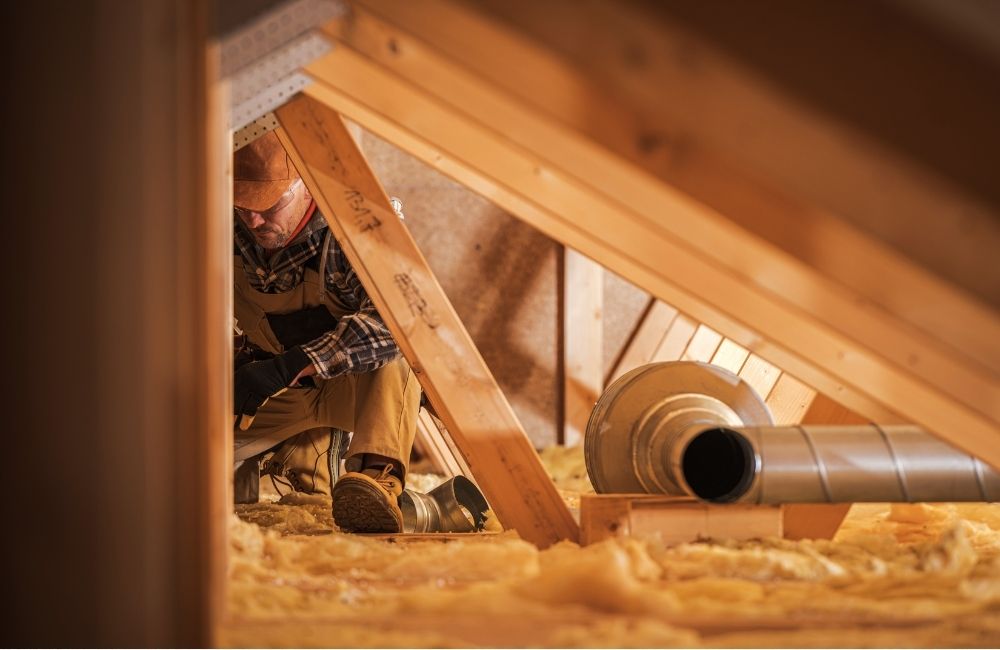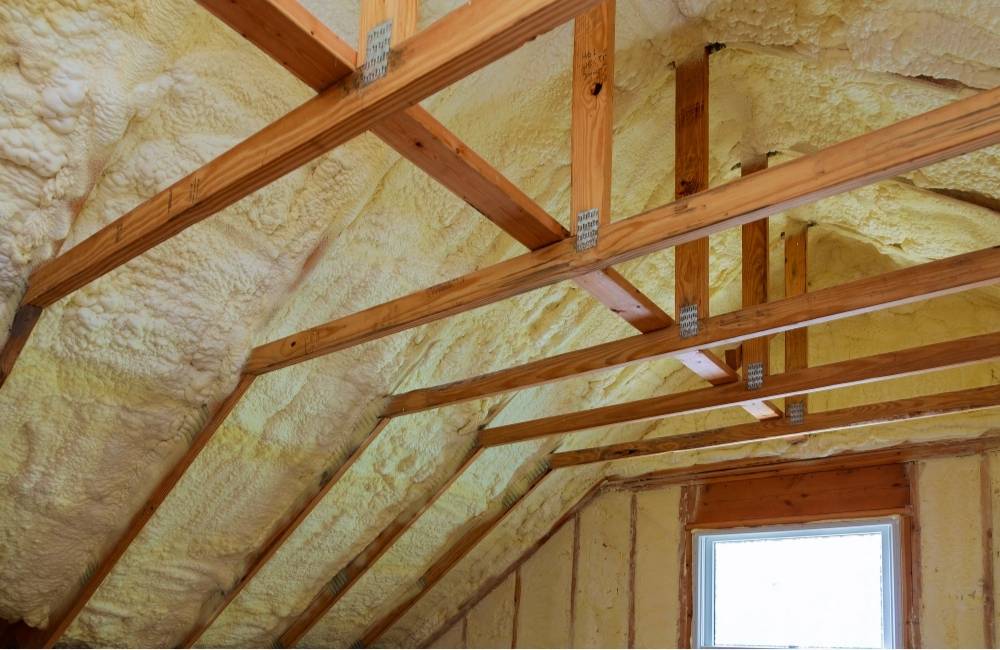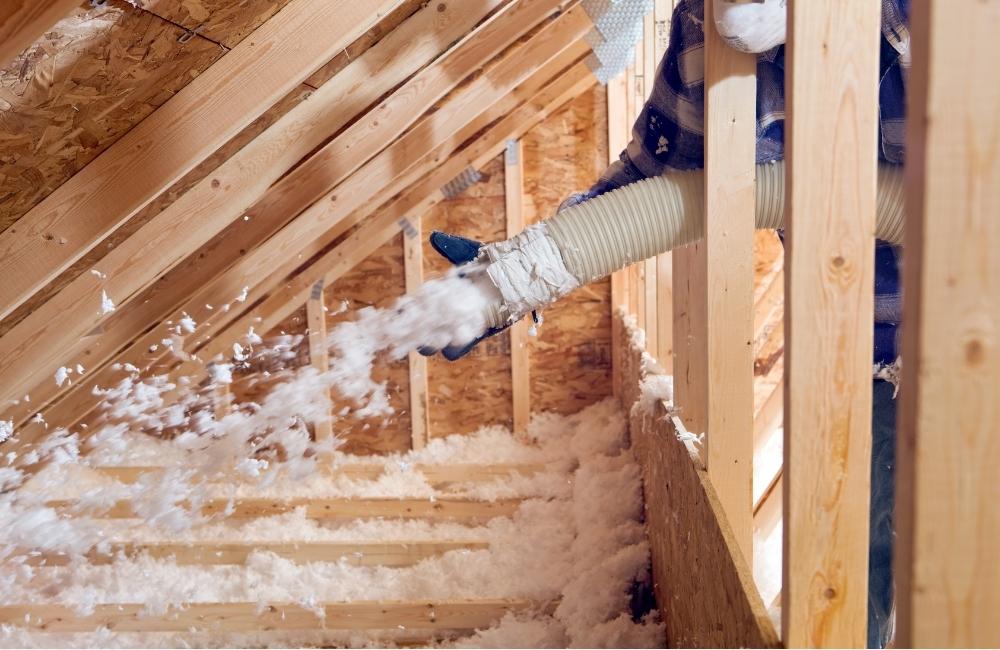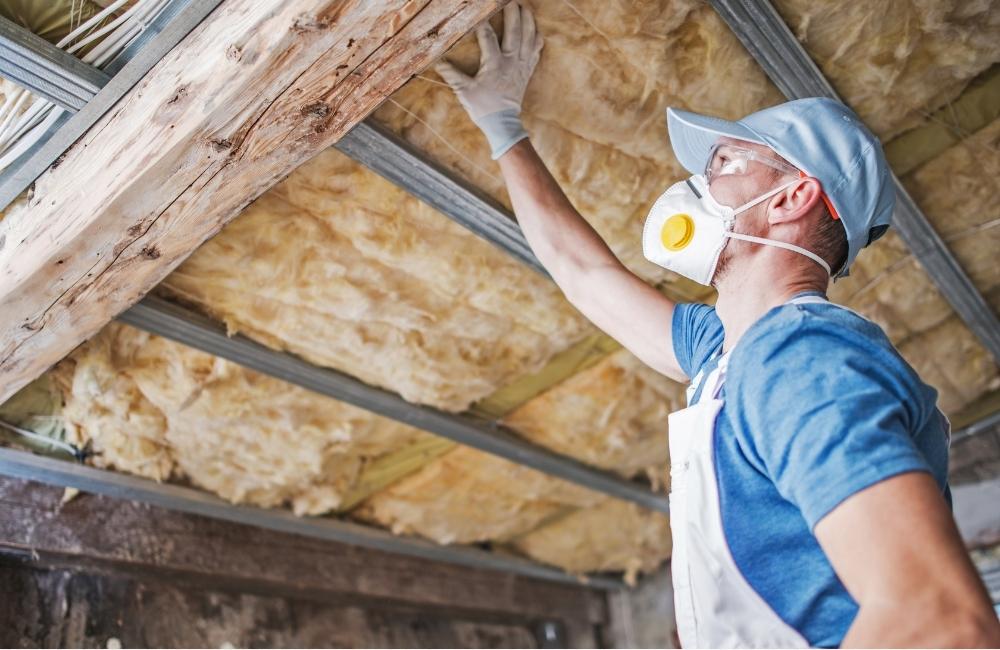Attic insulation is a cost-effective upgrade that enhances comfort, reduces energy bills, and eases strain on HVAC systems. It minimizes energy waste and extends equipment lifespan, leading to long-term savings and increased property value by maintaining stable indoor temperatures.
Here are five ways attic insulation saves you money.
Table of Contents
Key Takeaways
✔ Proper attic insulation helps maintain consistent indoor temperatures and reduces energy consumption.
✔ Upgrading attic insulation leads to significant cost savings on heating and cooling bills.
✔ Choosing the right insulation contractor ensures quality installation and long-term insulation cost benefits.
✔ Regular inspections and maintenance help preserve insulation effectiveness and maximize energy-efficient insulation.
✔ Addressing signs of poor insulation early can prevent costly repairs and improve overall home comfort.
✔ Investing in quality attic insulation can increase property value and appeal to potential buyers.✔ Energy-efficient insulation contributes to a more sustainable home by reducing carbon emissions and energy waste.

1. Lower Energy Bills
Attic insulation savings start with reducing heating and cooling costs. Proper insulation helps maintain a consistent indoor temperature, preventing excessive energy use. This leads to noticeable reductions in monthly utility bills, offering both immediate and long-term financial benefits.
Why Attic Insulation Reduces Energy Costs
- Prevents Heat Loss: Insufficient insulation allows warm air to escape during colder months, forcing heating systems to work harder. Energy-efficient insulation helps retain indoor heat, keeping spaces warmer with less energy consumption.
- Blocks Heat Gain: In warmer seasons, an uninsulated attic allows heat to enter, making cooling systems run longer and use more power. Quality insulation acts as a barrier, reducing the need for excessive air conditioning.
- Improves HVAC Efficiency: Without proper insulation, HVAC systems cycle more frequently to maintain indoor temperatures. By minimizing temperature fluctuations, insulation reduces strain on equipment, leading to lower energy costs.
How to Achieve Maximum Energy Savings with Attic Insulation
- Choose the Right Insulation Type: Fiberglass, cellulose, and spray foam each provide different levels of energy-efficient insulation. Selecting the appropriate material based on climate and budget ensures optimal performance and insulation cost benefits.
- Seal Air Leaks: Small gaps and cracks around the attic can undermine insulation effectiveness by letting air escape. Properly sealing these areas enhances insulation performance and boosts attic insulation savings.
- Maintain Insulation Levels: Over time, insulation can settle or degrade, reducing its effectiveness. Regular inspections and top-ups ensure consistent energy-efficient insulation and sustained savings.
2. Enhanced Indoor Comfort
Attic insulation savings go beyond reducing costs; they also improve indoor comfort throughout the year. Proper insulation keeps living spaces at consistent temperatures without sudden changes. This creates a more enjoyable and livable environment for everyone in the household.
Why Attic Insulation Improves Comfort
- Reduces Drafts: Gaps in attic insulation allow cold or hot air to seep into living spaces, causing uncomfortable drafts. Energy-efficient insulation blocks these air leaks, maintaining a stable indoor climate.
- Minimizes Temperature Fluctuations: Poor insulation leads to rooms that feel too hot in summer and too cold in winter. Proper insulation ensures even temperatures across all areas, eliminating hot and cold spots.
- Dampens Noise: Attic insulation provides an extra layer of soundproofing by absorbing outdoor noise. This helps create a quieter and more peaceful indoor environment, improving overall comfort.
How to Optimize Comfort with Attic Insulation
- Upgrade to Higher R-Value Insulation: Choosing insulation with a higher R-value improves thermal resistance, enhancing indoor comfort. Checking local climate recommendations helps determine the right insulation level for maximum comfort and insulation cost benefits.
- Ensure Proper Ventilation: Good attic ventilation works alongside insulation to regulate humidity and temperature. Installing ridge vents or attic fans prevents moisture buildup and enhances insulation effectiveness.
- Inspect for Moisture Issues: Damp or moldy insulation loses its ability to regulate temperatures efficiently. Regular attic inspections can identify leaks or condensation issues early, preserving insulation performance.
3. Prolonged HVAC System Lifespan
Energy-efficient insulation helps HVAC systems operate efficiently by reducing the workload on heating and cooling equipment. When the system doesn’t have to compensate for poor insulation, it lasts longer. This lowers repair costs and delays the need for a costly replacement.
Why Insulation Extends HVAC Lifespan
- Reduces System Overload: Without proper insulation, HVAC units run continuously to maintain set temperatures, leading to premature wear and tear. Effective attic insulation savings result from reduced system strain and fewer breakdowns.
- Maintains Optimal Airflow: Insulation helps regulate indoor air movement, allowing HVAC systems to operate at peak efficiency. This balanced airflow prevents short cycling and enhances equipment longevity.
- Prevents Dust Buildup: Poor insulation allows dust and debris to infiltrate ducts and clog filters. Energy-efficient insulation minimizes airborne particles, helping HVAC systems function smoothly with fewer maintenance issues.
How to Protect HVAC Systems with Attic Insulation
- Seal Ductwork Properly: Leaky ducts waste energy and force HVAC systems to work harder. Sealing duct joints and connections prevents air leaks and supports the insulation cost benefits. Sealing air leaks and adding insulation in key areas like attics and basements can help homeowners save around 15% on heating and cooling costs.
- Regularly Change Air Filters: A clean air filter allows the HVAC system to circulate air efficiently. Checking and replacing filters every few months prevents dust accumulation and ensures system longevity.
- Insulate Ducts in the Attic: Adding insulation around ductwork prevents heat loss or gain during air distribution. This enhances HVAC performance and maximizes attic insulation savings.

4. Increased Home Value
A well-insulated attic is an attractive feature for potential buyers, showcasing a home’s energy efficiency and lower operating costs. Buyers are often willing to pay more for a property with energy-efficient insulation already in place. Investing in insulation provides long-term value beyond just monthly savings.
Why Insulation Boosts Home Value
- Improves Energy Efficiency Ratings: Homes with updated insulation often receive higher energy performance scores, making them more appealing to buyers. A good rating can increase the marketability of a property.
- Enhances Structural Integrity: Proper insulation helps prevent moisture buildup, which can lead to mold growth and wood rot. A well-maintained structure adds to the overall value and appeal of the home.
- Reduces Future Maintenance Needs: Quality attic insulation prevents issues like frozen pipes or excessive humidity damage. Buyers appreciate homes with fewer maintenance concerns, making them more willing to invest.
How to Maximize Home Value with Attic Insulation
- Choose Eco-Friendly Insulation Options: Using sustainable materials like recycled cellulose or spray foam appeals to environmentally conscious buyers. Green insulation solutions can further enhance property value.
- Get a Professional Energy Audit: A home energy audit can provide proof of energy-efficient insulation improvements. Displaying these reports during property showings can attract serious buyers.
- Highlight Insulation Upgrades in Listings: Clearly stating recent insulation improvements in property listings can make the home stand out. Mentioning insulation cost benefits and energy savings can entice potential buyers.
5. Lower Environmental Impact
Adding energy-efficient insulation reduces a home’s carbon footprint by decreasing overall energy consumption. With less reliance on heating and cooling systems, fewer greenhouse gases are emitted. This small change contributes to broader environmental sustainability efforts.
Why Insulation Benefits the Environment
- Reduces Carbon Emissions: Lower energy consumption means power plants produce fewer emissions. A well-insulated attic supports sustainability goals by cutting down on fossil fuel use.
- Decreases Waste in Landfills: Using long-lasting insulation materials prevents the need for frequent replacements. Durable options like spray foam and fiberglass reduce material waste over time.
- Conserves Natural Resources: Insulating a home efficiently reduces the demand for electricity and gas. This contributes to preserving valuable resources such as coal, oil, and water.
How to Make Insulation More Eco-Friendly
- Opt for Sustainable Materials: Insulation made from recycled or renewable materials, like wool or denim, provides energy savings without harming the environment. Choosing these options supports sustainability efforts.
- Ensure Proper Disposal of Old Insulation: Removing outdated insulation should be done responsibly to minimize landfill waste. Recycling insulation materials where possible helps reduce environmental impact.
Install Smart Home Energy Monitors: Tracking energy usage with smart devices can identify additional ways to improve insulation performance. Monitoring consumption helps homeowners achieve greater attic insulation savings.
How to Spot Poor Attic Insulation
Identifying poor attic insulation early can prevent costly energy losses and uncomfortable living conditions. Insulation that isn’t performing well can lead to temperature fluctuations, higher utility bills, and potential structural issues. Knowing what to look for helps homeowners take proactive steps to improve energy efficiency and maximize attic insulation savings.
1. Inconsistent Indoor Temperatures
A common sign of inadequate attic insulation is uneven temperatures throughout the home, with certain rooms feeling much warmer in summer or colder in winter. This happens because heat naturally moves from warm areas to cooler ones, escaping from heated rooms to unheated spaces like attics, garages, and the outdoors. As a result, heating and cooling systems must work harder to maintain a consistent indoor climate.
2. Rising Energy Bills
An unexplained increase in heating and cooling costs often points to poor insulation in the attic. Without proper insulation, conditioned air escapes easily, making HVAC systems run longer to compensate for the loss. This results in higher monthly utility bills, despite no change in usage habits. Investing in insulation cost benefits by improving energy efficiency and reducing unnecessary energy waste.
3. Cold Drafts or Hot Spots
Feeling cold drafts during the winter or noticing warm areas near ceilings in the summer can indicate gaps in attic insulation. These issues occur when insulation fails to provide a consistent thermal barrier, allowing outdoor air to seep in. Proper insulation fills these gaps, ensuring that air leaks are minimized and indoor comfort is maintained year-round. Addressing drafts with energy-efficient insulation leads to better climate control and attic insulation savings.
4. Ice Dams on the Roof
Ice dams forming along the roof’s edge in winter signal inadequate attic insulation. When heat escapes through the attic, it melts the snow on the roof, which then refreezes at the eaves, causing ice buildup. This not only leads to potential water damage but also stresses the roof structure. Upgrading attic insulation prevents heat loss and minimizes the risk of ice dams forming.
5. Pest Infestations
An attic that is not properly insulated can become an entry point for pests such as rodents and insects. Gaps and weak spots in insulation provide easy access for unwanted critters looking for shelter. Signs of pests, such as droppings or nests, may indicate insulation damage that needs immediate attention. Ensuring the attic is well-sealed with energy-efficient insulation helps keep pests out while improving insulation cost benefits.
How to Select the Right Insulation Contractor
Choosing the right insulation contractor in Pleasant Valley, NY, is essential for maximizing attic insulation savings and ensuring energy-efficient insulation performance. A reliable contractor can help achieve proper installation, which leads to long-term insulation cost benefits.
1. Verify Licensing and Certifications
A reputable insulation contractor should have the necessary licenses and certifications to perform the job safely and efficiently. Certifications from organizations like the Building Performance Institute (BPI) or North American Insulation Manufacturers Association (NAIMA) indicate that the contractor follows industry standards. Verifying credentials ensures that the contractor is qualified to deliver energy-efficient insulation solutions.
2. Evaluate Experience and Expertise
Experience matters when it comes to insulation installation, as improper techniques can reduce effectiveness and lead to higher energy costs. An experienced contractor will have a proven track record of successful projects and knowledge of various insulation materials. Asking about their experience with specific attic insulation savings strategies can help ensure the right fit for the project.
3. Request Detailed Quotes
A professional contractor should provide a detailed written estimate that outlines the scope of work, materials, and costs involved. Comparing quotes from multiple contractors allows homeowners to evaluate insulation cost benefits and avoid hidden fees. A transparent quote ensures that expectations are clear and the investment in energy-efficient insulation is worthwhile.
4. Check Customer Reviews and References
Reading online reviews and speaking with past clients can provide insight into a contractor’s reliability and workmanship quality. Satisfied customers often highlight aspects such as timely completion, professionalism, and overall satisfaction with attic insulation savings. Asking for references allows homeowners to verify firsthand the contractor’s ability to meet expectations.
5. Inquire About Warranties and Guarantees
A trustworthy insulation contractor should offer warranties on both materials and labor to ensure long-term performance. Warranties provide peace of mind that any potential issues will be addressed without additional costs. Choosing a contractor who stands behind their work helps maximize insulation cost benefits and guarantees lasting results.

Frequently Asked Questions (FAQs)
How does attic insulation impact indoor air quality?
Attic insulation helps improve indoor air quality by reducing the infiltration of outdoor pollutants, allergens, and moisture. Properly installed energy-efficient insulation creates a barrier that prevents dust, mold spores, and other airborne contaminants from entering living spaces. This contributes to a healthier indoor environment by maintaining consistent humidity levels and reducing the risk of mold growth.
Can attic insulation help with noise reduction?
Yes, attic insulation can effectively reduce noise from outside sources such as traffic, construction, and weather. Energy-efficient insulation materials like spray foam or cellulose help absorb sound vibrations, preventing them from traveling through ceilings and walls. This makes a significant difference in multi-story homes or areas with high external noise levels. In addition to attic insulation savings, better soundproofing contributes to a quieter and more peaceful indoor environment.
How often should attic insulation be replaced?
The lifespan of attic insulation depends on the type of material used and environmental conditions, but most insulation can last between 15 to 30 years. Factors such as moisture exposure, pest infestations, and settling can reduce its effectiveness over time. Regular inspections help determine when insulation needs replacement to maintain insulation cost benefits and energy efficiency. Upgrading old insulation ensures that energy-efficient insulation continues to provide optimal performance and savings.
Does attic insulation affect home insurance premiums?
In some cases, upgrading attic insulation can positively impact home insurance premiums by improving fire resistance and reducing the risk of damage from extreme weather. Certain energy-efficient insulation materials, such as spray foam, offer enhanced fire-retardant properties that can lead to discounts on insurance rates. Insurers may also recognize the insulation’s ability to prevent costly damage caused by moisture and temperature fluctuations.
What are the best insulation options for homes with solar panels?
Homes with solar panels can benefit from insulation materials that enhance energy efficiency and complement renewable energy systems. Reflective insulation and spray foam work well in such homes by minimizing heat transfer and maximizing energy-efficient insulation performance. These options help optimize energy savings by reducing the overall demand for heating and cooling. Combining solar energy with proper attic insulation maximizes insulation cost benefits and enhances sustainable living efforts.
Boost Comfort and Savings with Attic Insulation from Roofer of Pleasant Valley!
Roofer of Pleasant Valley provides top-quality attic insulation services designed to enhance energy efficiency and lower utility costs. With a commitment to expert craftsmanship and personalized solutions, our team ensures homes in Pleasant Valley, NY, stay comfortable year-round while maximizing energy savings. Whether it’s upgrading old insulation or installing new materials, we focus on delivering long-lasting results that improve home performance. Trust

